- Position:sunny or partly shaded north facing wall/fence sheltered from frost and strong winds. Plant 1.5m (5ft) apart in rows 1.5m (5ft) apart.
- Soil:slightly acid, moist but well-drained fertile soil.
- After care: Cut back the main branches by one-half after planting. Create a framework of 8-10 branches. Each Winter from year 3 shorten main shoots by one-half. Apply a general fertiliser in Spring.
-
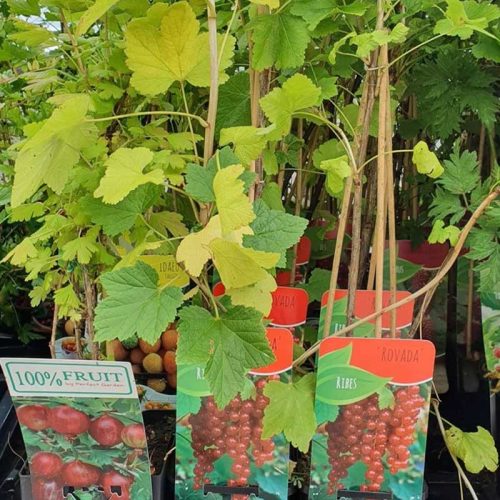
-
Out of stock
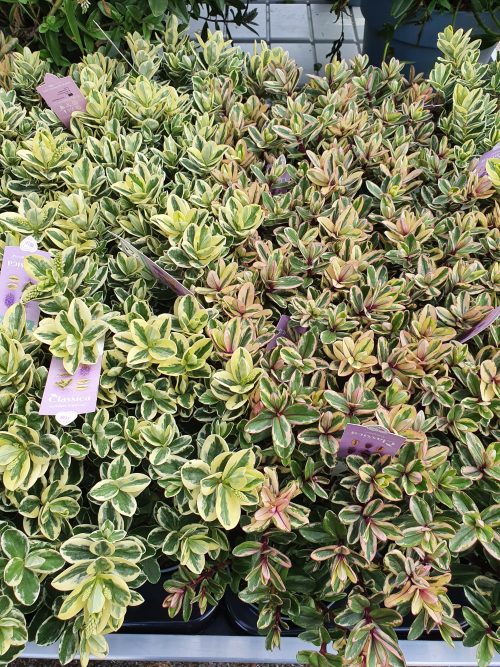 Katrina' is a compact, upright, bushy, evergreen shrub bearing broadly elliptic, grey-green leaves with pale yellow margins and dense racemes of purple flowers in summer. Plant Size • Mature Height: 0.5-1m • Mature Spread: 0.5-1m Why We Love It • Excellent addition to beds, borders and containers • Attracts butterflies and bees What To Know • Season of Interest: Winter-Autumn • Position: Full sun, partial shade • Soil: Moist, well-drained How to Care • The hebe plant does not require a lot of care once it is established. Although the shrub doesn’t need much in the way of fertilizer, you can apply some once a year in late winter or early spring prior to new growth. • Deadheading the spent blooms can be done to help promote additional flowering. You can also trim hebe plants back about halfway after flowering to promote bushier growth. • These shrubs are usually propagated through both seeds and semi-hardwood cuttings taken in summer. • In areas with harsher winters, they should be protected by surrounding them with straw mulch.
Katrina' is a compact, upright, bushy, evergreen shrub bearing broadly elliptic, grey-green leaves with pale yellow margins and dense racemes of purple flowers in summer. Plant Size • Mature Height: 0.5-1m • Mature Spread: 0.5-1m Why We Love It • Excellent addition to beds, borders and containers • Attracts butterflies and bees What To Know • Season of Interest: Winter-Autumn • Position: Full sun, partial shade • Soil: Moist, well-drained How to Care • The hebe plant does not require a lot of care once it is established. Although the shrub doesn’t need much in the way of fertilizer, you can apply some once a year in late winter or early spring prior to new growth. • Deadheading the spent blooms can be done to help promote additional flowering. You can also trim hebe plants back about halfway after flowering to promote bushier growth. • These shrubs are usually propagated through both seeds and semi-hardwood cuttings taken in summer. • In areas with harsher winters, they should be protected by surrounding them with straw mulch. -
Out of stock
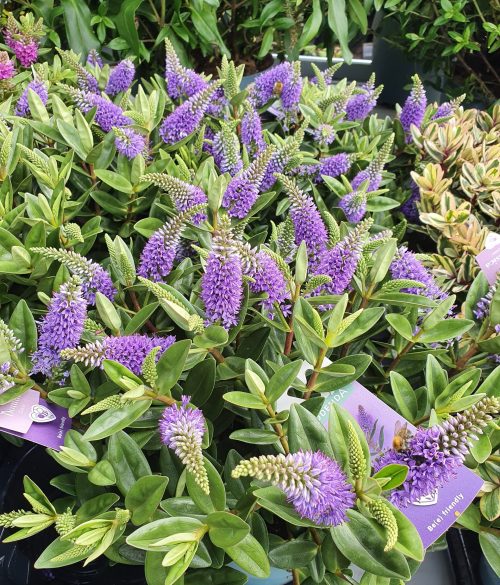 Hebe Donna is a compact evergreen shrub. Mauve blooms appear in July until the first frosts. Deadhead regularly so that more blooms will be produced. Cover with fleece during winter months to protect from frosts. Plant Type: Evergreen Shrub Plant Height & Spread: 100cm x 100cm Foliage Colour: Green Foliage Type: Evergreen Seasons of Interest: All Seasons Soil Condition: Moist, well-drained Planting Position: Full Sun/Light Shade, Sheltered Plant Care & Advice The hebe plant does not require a lot of care once it is established. Although the shrub doesn't need much in the way of fertilizer, you can apply some once a year in late winter or early spring prior to new growth. Growing a hebe plant is very easy. The versatility of these shrubs allows you to grow them in different ways. Use them for edging, plant them in borders, grow them in rock gardens or even in containers. To help keep your Hebe flowering well, remove the dead heads from the plant when they start to shrivel up. You could give your Hebe a trim all over in the early winter. This will help keep your plant attractive and strong.
Hebe Donna is a compact evergreen shrub. Mauve blooms appear in July until the first frosts. Deadhead regularly so that more blooms will be produced. Cover with fleece during winter months to protect from frosts. Plant Type: Evergreen Shrub Plant Height & Spread: 100cm x 100cm Foliage Colour: Green Foliage Type: Evergreen Seasons of Interest: All Seasons Soil Condition: Moist, well-drained Planting Position: Full Sun/Light Shade, Sheltered Plant Care & Advice The hebe plant does not require a lot of care once it is established. Although the shrub doesn't need much in the way of fertilizer, you can apply some once a year in late winter or early spring prior to new growth. Growing a hebe plant is very easy. The versatility of these shrubs allows you to grow them in different ways. Use them for edging, plant them in borders, grow them in rock gardens or even in containers. To help keep your Hebe flowering well, remove the dead heads from the plant when they start to shrivel up. You could give your Hebe a trim all over in the early winter. This will help keep your plant attractive and strong. -
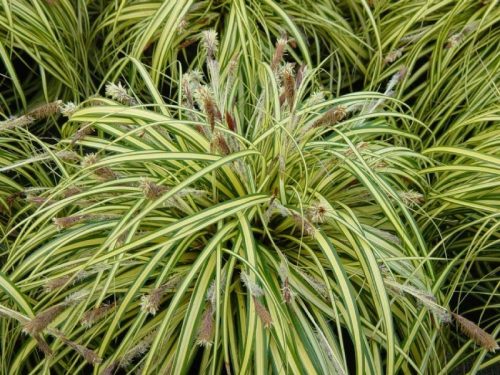
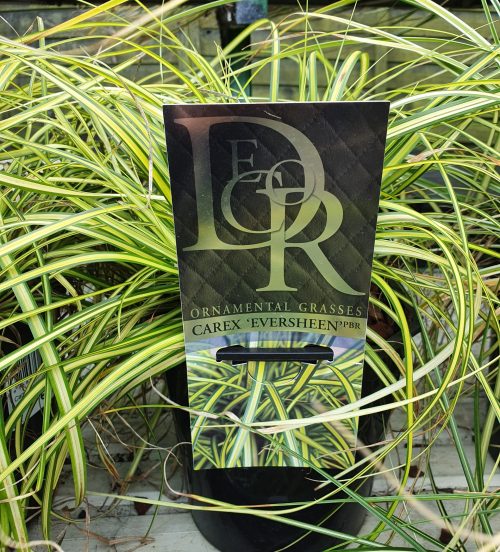 The citrus lemon-yellow blades edged in green add a refreshing zest even in the winter garden. Neat habit is perfect for container planting. Colorful year-round, the flowing arching mounds of Carex Eversheen is perfectly suited for shade, but can handle some sun in cooler climates. A pleasing addition to any spot as it bends and sways with the warm summer breezes. A nice edger. 0.4m height x 0.4m spread
The citrus lemon-yellow blades edged in green add a refreshing zest even in the winter garden. Neat habit is perfect for container planting. Colorful year-round, the flowing arching mounds of Carex Eversheen is perfectly suited for shade, but can handle some sun in cooler climates. A pleasing addition to any spot as it bends and sways with the warm summer breezes. A nice edger. 0.4m height x 0.4m spread -
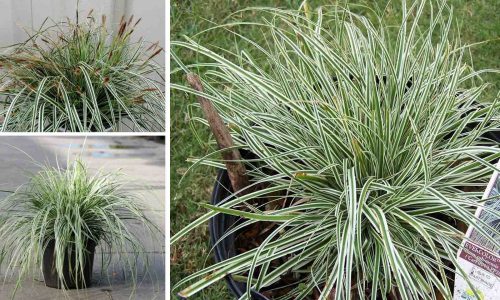
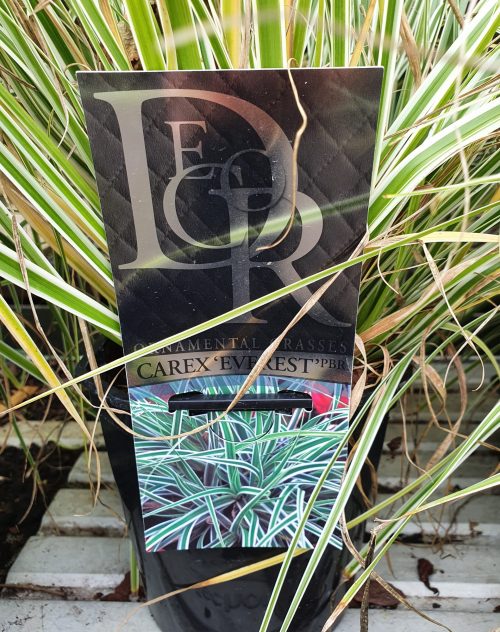 ‘Everest’ is a dense, tufted, evergreen, perennial grass forming a mound of narrow, arching, glossy, dark green leaves with white margins and lax stems bearing brown flower spikes in summer. 0.6m height x 0.6m spread 2-5 years until maturity
‘Everest’ is a dense, tufted, evergreen, perennial grass forming a mound of narrow, arching, glossy, dark green leaves with white margins and lax stems bearing brown flower spikes in summer. 0.6m height x 0.6m spread 2-5 years until maturity -
Out of stock
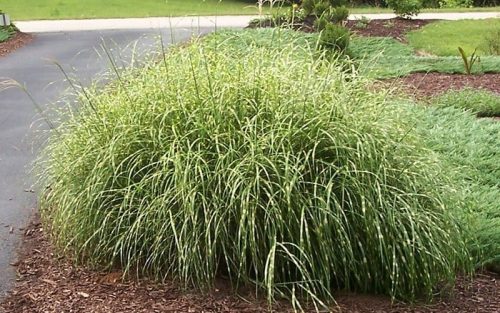
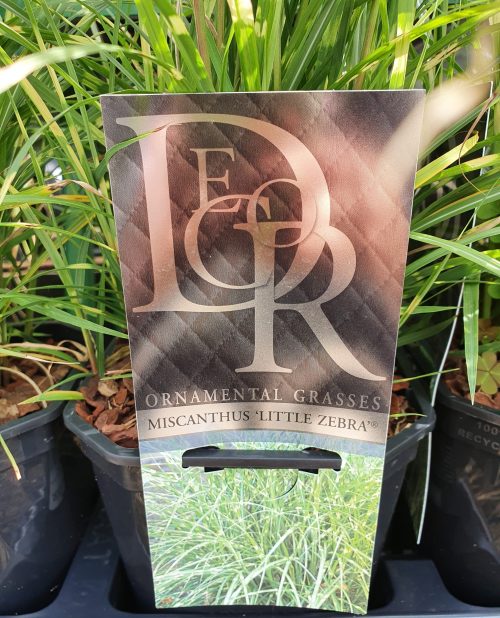 Little Zebra Grass features horizontal gold-and-green bands and a compact, mounding habit. In early fall, this spunky grass sends out attractive reddish, fan-shaped blooms that are held one foot above the foliage. The plumes change to a creamy tan color providing winter interest in the landscape. Because of its size and shape, Little Zebra Grass is the right proportion for small gardens, patios and decks. Its decorative leaves earn it a favored spot in large planters and urns. This sturdy dwarf Miscanthus holds its shape. Miscanthus sinensis ‘Little Zebra’ is unlikely to reseed because of its late-blooming characteristic. Foliage Type: Deciduous. Foliage: Green and Creamy-Yellow. Flower: Pale Pink to Silver. Flowering Period: Late-Summer. Suggested Location: Outdoor or Indoor. Suggested Soil Type: Well-Drained. Sand. Clay. Chalk. Loam. Suggested Exposure to Sunlight: Full Sunlight. Suggested Exposure to Weather: Exposed or Sheltered. Hardiness Rating: High Lowest Temperature Tolerance: -20 °C to -15 °C (-4 °F to 5 °F) Suggested Uses: Rock Gardens. Borders. Containers. Arrangements of Cut Flowers. Maintenance: Remove dead leaves and flowers in spring. Protect against excessive wet weather. Growth Habit: Bushy/Weeping. Growth Speed: Medium (30cm to 50cm per year) Starting Height: 30cm to 60cm (1.0 ft to 2.0 ft) Final Height: 100cm (3.2 ft) Starting Sideways Spread: 20cm to 40cm (0.7 ft to 1.3 ft) Final Sideways Spread: 100cm (3.2 ft)
Little Zebra Grass features horizontal gold-and-green bands and a compact, mounding habit. In early fall, this spunky grass sends out attractive reddish, fan-shaped blooms that are held one foot above the foliage. The plumes change to a creamy tan color providing winter interest in the landscape. Because of its size and shape, Little Zebra Grass is the right proportion for small gardens, patios and decks. Its decorative leaves earn it a favored spot in large planters and urns. This sturdy dwarf Miscanthus holds its shape. Miscanthus sinensis ‘Little Zebra’ is unlikely to reseed because of its late-blooming characteristic. Foliage Type: Deciduous. Foliage: Green and Creamy-Yellow. Flower: Pale Pink to Silver. Flowering Period: Late-Summer. Suggested Location: Outdoor or Indoor. Suggested Soil Type: Well-Drained. Sand. Clay. Chalk. Loam. Suggested Exposure to Sunlight: Full Sunlight. Suggested Exposure to Weather: Exposed or Sheltered. Hardiness Rating: High Lowest Temperature Tolerance: -20 °C to -15 °C (-4 °F to 5 °F) Suggested Uses: Rock Gardens. Borders. Containers. Arrangements of Cut Flowers. Maintenance: Remove dead leaves and flowers in spring. Protect against excessive wet weather. Growth Habit: Bushy/Weeping. Growth Speed: Medium (30cm to 50cm per year) Starting Height: 30cm to 60cm (1.0 ft to 2.0 ft) Final Height: 100cm (3.2 ft) Starting Sideways Spread: 20cm to 40cm (0.7 ft to 1.3 ft) Final Sideways Spread: 100cm (3.2 ft) -
Out of stock
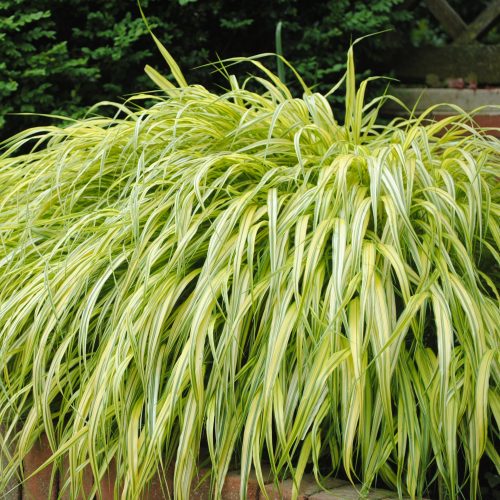
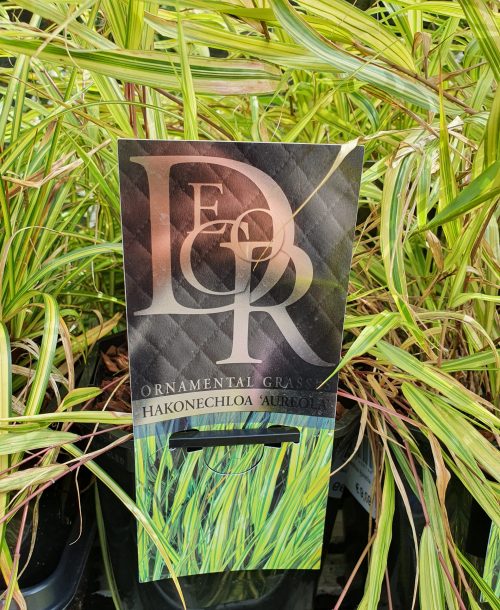 A cultivar of Japanese forest grass which makes a splash of colour in the garden, Hakonechloa macra Aureola is a clump-forming, deciduous, perennial grass which forms a broad, low, dense mound of narrow, arching, rather bamboo-like leaves. They are butter-yellow, striped with green, appear in early spring, keep their bright colour throughout the season, and are often tinged with coppery red in autumn. The colour is best in partial shade, turning shades of green in full shade. Tiny, insignificant, brown flowers appear in summer. Golden hakonechloa is tough, easy-to-grow and very hardy. It holds the RHS Award of Garden Merit. Site: Tolerates exposure Soil: Any moist but well-drained soil Position: Colours best in partial shade; tolerates full sun and full shade Season of interest: Spring to autumn Hardiness: Very hardy Height: 14”’ (35cm) Spread: 16” (40cm)
A cultivar of Japanese forest grass which makes a splash of colour in the garden, Hakonechloa macra Aureola is a clump-forming, deciduous, perennial grass which forms a broad, low, dense mound of narrow, arching, rather bamboo-like leaves. They are butter-yellow, striped with green, appear in early spring, keep their bright colour throughout the season, and are often tinged with coppery red in autumn. The colour is best in partial shade, turning shades of green in full shade. Tiny, insignificant, brown flowers appear in summer. Golden hakonechloa is tough, easy-to-grow and very hardy. It holds the RHS Award of Garden Merit. Site: Tolerates exposure Soil: Any moist but well-drained soil Position: Colours best in partial shade; tolerates full sun and full shade Season of interest: Spring to autumn Hardiness: Very hardy Height: 14”’ (35cm) Spread: 16” (40cm) -
Out of stock
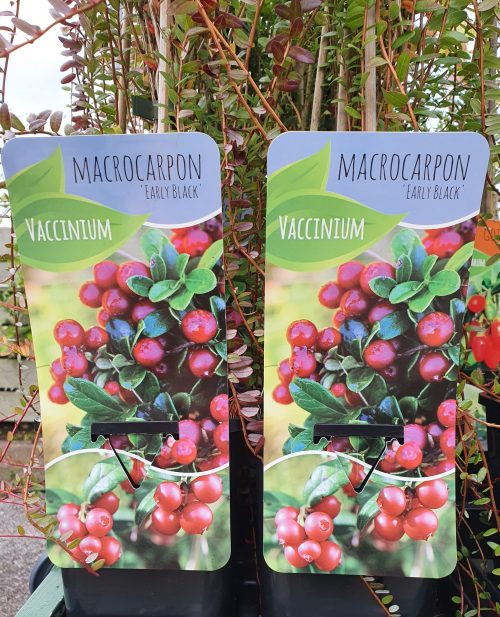
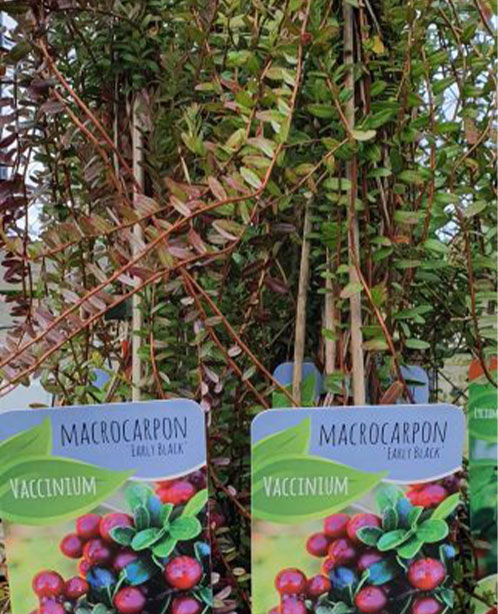 The fruits of 'Early Black' aren't actually black - starting off bright red they ripen to a deep purple-red that could easily be mistaken for black. But it certainly lives up to the 'Early in its name, cropping from late August - which makes it the earliest variety. High in Vitamin C, the fruits can be made into pies and puddings, crushed and made into juice, or made into Cranberry Jelly - perfect for the Christmas Turkey! Growing to a maximum of around 2 feet (60 cm) tall, this small evergreen bush does best in a full sun or a semi-shade position where it can be allowed to scramble as it wishes. Harvest from late August. Suitable for both open ground or container growing. For open ground planting plant 12" x 12" (30 x 30 cm) apart. Ericaceous, so will require soil or compost of an acidic nature. Self-fertile.
The fruits of 'Early Black' aren't actually black - starting off bright red they ripen to a deep purple-red that could easily be mistaken for black. But it certainly lives up to the 'Early in its name, cropping from late August - which makes it the earliest variety. High in Vitamin C, the fruits can be made into pies and puddings, crushed and made into juice, or made into Cranberry Jelly - perfect for the Christmas Turkey! Growing to a maximum of around 2 feet (60 cm) tall, this small evergreen bush does best in a full sun or a semi-shade position where it can be allowed to scramble as it wishes. Harvest from late August. Suitable for both open ground or container growing. For open ground planting plant 12" x 12" (30 x 30 cm) apart. Ericaceous, so will require soil or compost of an acidic nature. Self-fertile. -
Out of stock
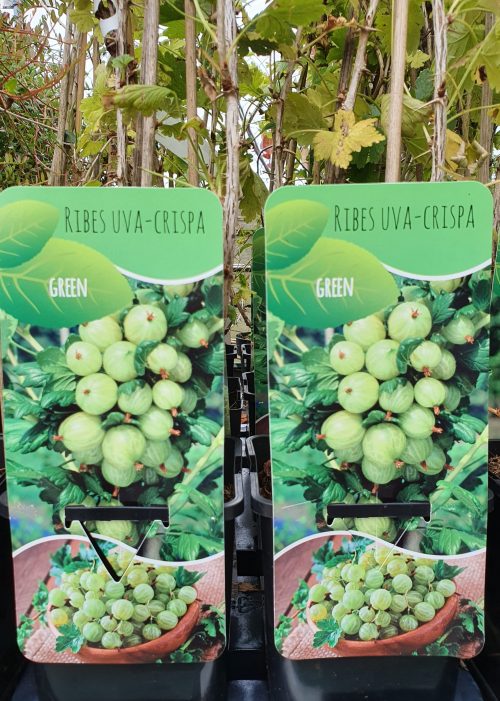
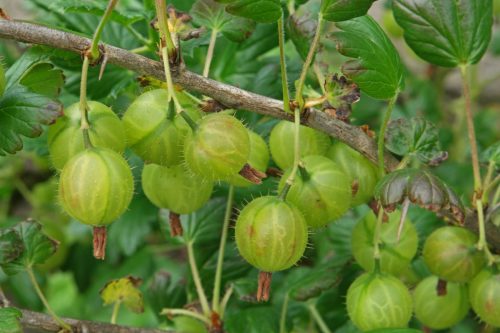
Gooseberries are a staple of the British cottage garden. They’re easy to grow and can thrive in many kinds of soil, as long as they’re grown in full sun. Grow them as compact bushes or train them against a wall. You can also grow gooseberry bushes in containers.Grow in fertile, well-drained soil in a sunny, sheltered site. If growing as a bush, prune gooseberries annually to maintain an open, bowl-shape, which makes picking easier. How to grow Ribes uva-crispa
-
Plant size
1.5m height
1.5m spread
-
Aspect
South facing, west facing
- Sun exposure: Full sun
- Hardiness: Hardy
- Soil type: Well drained / light / sandy
-
-
Out of stock
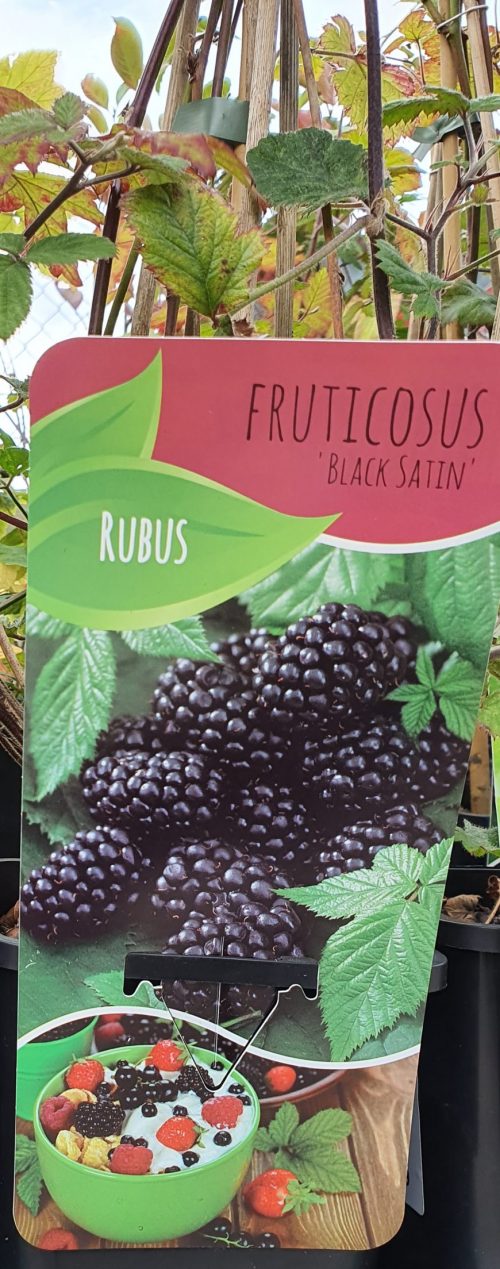
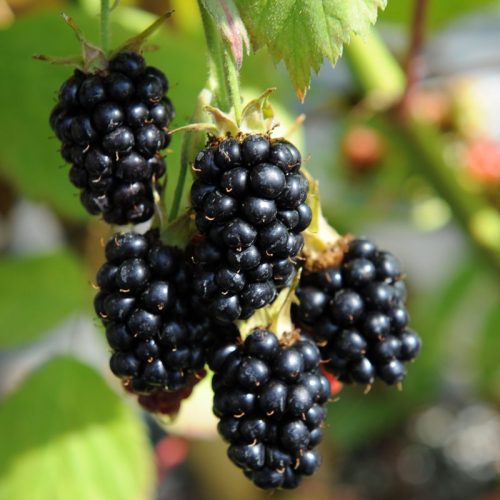 A thornless, American-bred blackberry, Rubus fruticosus Black Satin produces medium to large, rounded, black very juicy berries with a delicious, rather sharp flavour from late July, earlier than most thornless blackberries. Beautiful pale pink flowers and fruit are borne on two-year-old wood; yields are high and reliable. Blackberry Black Satin is a deciduous shrub with upright canes, to 10’/3m, which should be tied into post and wire supports or wires on a warm wall or fence to keep the plant from running rampant and make harvesting easier; cut down fruited canes and tie in new growth after the harvest. Good plant for pollinators. Site: Warm, sheltered, sunny site Soil: Any reasonable, well-drained soil, preferably neutral Position: Full sun Pick: From late July and through August Keep: Fruit does not keep, but freezes well Hardiness: Fully hardy Pollination: Self-fertile Uses: Eating fresh, cooking, preserving
A thornless, American-bred blackberry, Rubus fruticosus Black Satin produces medium to large, rounded, black very juicy berries with a delicious, rather sharp flavour from late July, earlier than most thornless blackberries. Beautiful pale pink flowers and fruit are borne on two-year-old wood; yields are high and reliable. Blackberry Black Satin is a deciduous shrub with upright canes, to 10’/3m, which should be tied into post and wire supports or wires on a warm wall or fence to keep the plant from running rampant and make harvesting easier; cut down fruited canes and tie in new growth after the harvest. Good plant for pollinators. Site: Warm, sheltered, sunny site Soil: Any reasonable, well-drained soil, preferably neutral Position: Full sun Pick: From late July and through August Keep: Fruit does not keep, but freezes well Hardiness: Fully hardy Pollination: Self-fertile Uses: Eating fresh, cooking, preserving -
Out of stock
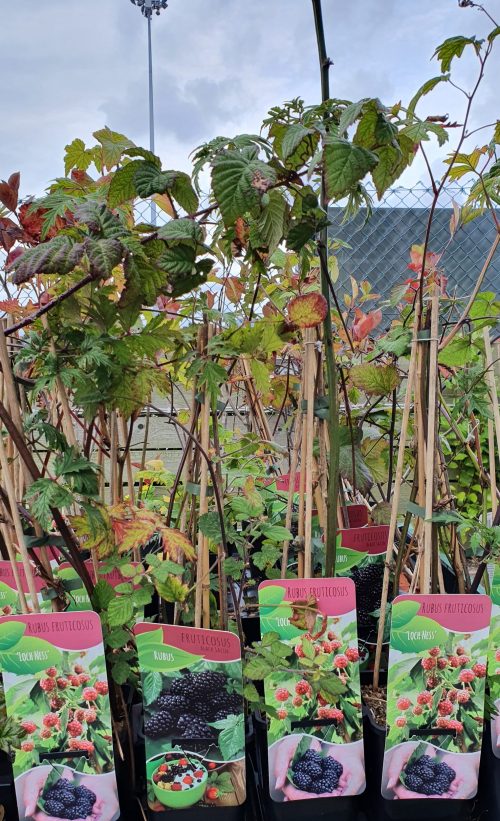
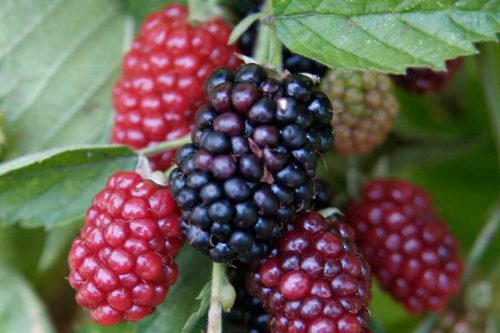 2.5m ht x 2.5m sp 2-5 years until maturity ‘Loch Ness’ is a moderate-sized bush with upright thornless canes, white flowers in summer followed by dark blackberries in late summer.
2.5m ht x 2.5m sp 2-5 years until maturity ‘Loch Ness’ is a moderate-sized bush with upright thornless canes, white flowers in summer followed by dark blackberries in late summer.Foliage
DeciduousHabit
SpreadingFlower
White in SummerFoliage
Dark-green in Spring; Dark-green in Summer; Pale-yellow in AutumnHOW TO CARE
Watch out for
Pests
It is best to rotate crops to avoid pest and disease problems.Specific pests
Aphids , Leafhoppers , Raspberry beetle , Raspberry leaf and bud miteGeneral care
Pruning
Prune old canes to ground level in late winter and tie in new canes.Propagation methods
LayeringWHERE TO GROW
Rubus fruticosus 'Loch Ness' (Blackberry 'Loch Ness') will reach a height of 2.5m and a spread of 2.5m after 2-5 years.Suggested uses
Add to salads, Banks and Slopes, Cake decoration, Containers, Cottage/Informal, Flavouring food and drinks, Hedging/ScreensCultivation
Plant outdoors in summer in well-drained neutral soil.Soil type
Clay, Loamy, SandySoil drainage
Moist but well-drained, Well-drainedSoil pH
NeutralLight
Full SunAspect
South, East, WestExposure
Sheltered -
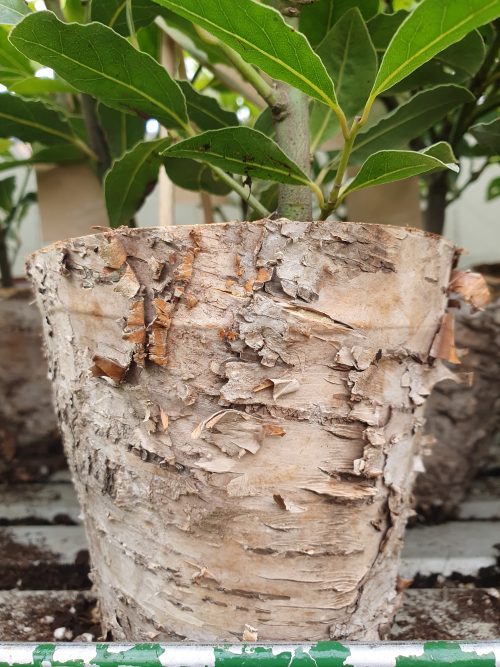
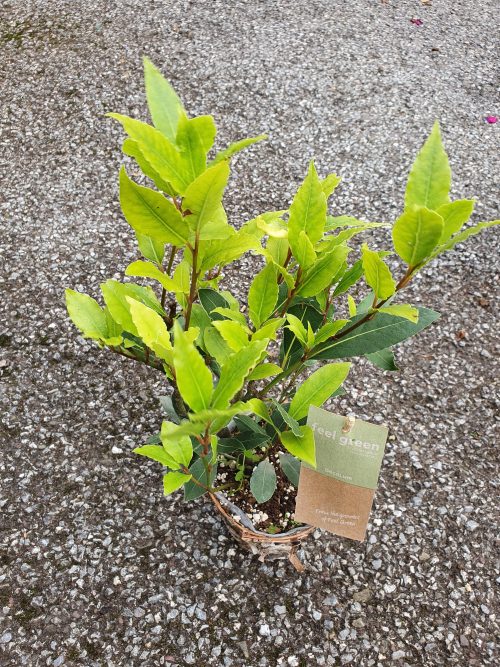 This sustainable laurel adds a Mediterranean touch to your garden (summer)/ house (winter).
This sustainable laurel adds a Mediterranean touch to your garden (summer)/ house (winter).